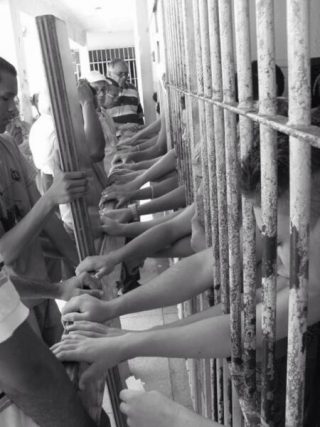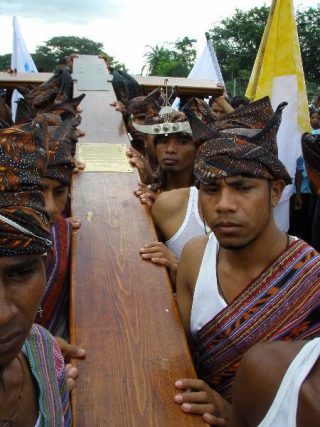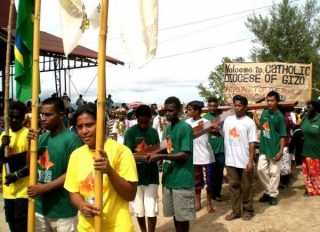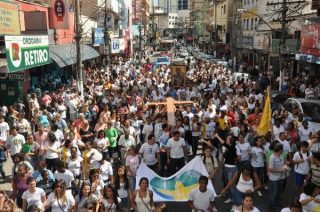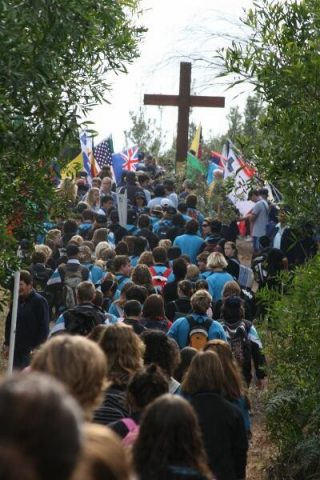It is known as the “Holy Year Cross”, the “Jubilee Cross”, the “WYD Cross”, the “Pilgrim Cross”. Many call it the “Youth Cross” as it was given to young people to take around the world to any place at any time. Here is the story of that Cross.
It was the Holy Year of the Redemption (1983-1984). Pope John Paul II felt that there should be a cross – the symbol of our faith – near the main altar in Saint Peter’s Basilica where it could be seen by everyone. A large wooden Cross, 3.8 metres high, was placed there according to the Holy Father’s desire.
At the end of the Holy Year, after the Pope had closed the Holy Door, he entrusted that Cross to the youth of the world, represented by the young people from the San Lorenzo Youth Centre in Rome. His words on that occasion were:
“My dear young people, at the conclusion of the Holy Year, I entrust to you the sign of this Jubilee Year: the Cross of Christ! Carry it throughout the world as a symbol of Christ’s love for humanity, and proclaim to everyone that it is only in Christ, who died and rose from the dead, that salvation and redemption are to be found” (Rome, 22 April 1984).
The youth responded to the Holy Father’s request. They took it to the San Lorenzo Youth Centre beside Saint Peter’s Square, and this was to be its home when it was not away on pilgrimage around the world.
The first pilgrimage of the Holy Year Cross (as it was known then) took place in July. The destination was Munich in Germany for the “Katholikentag”. It was just a simple wooden cross. At first sight, people did not see that it was anything special. Little by little they realised that it had come on a mission by desire of the Holy Father.
1985 was International Youth Year proclaimed by the United Nations, and 300,000 young people had a meeting with the Pope in Saint Peter’s Square on Palm Sunday. The Holy Year Cross was present at that meeting. During that year, the Cross was at youth meetings, it was taken on pilgrimage, and it led the Way of the Cross in city streets in various parts of Europe: Italy, France, Luxembourg, Ireland, Scotland, Malta and Germany. In December of that year, Pope John Paul II announced that there would be an annual World Youth Day beginning on the following Palm Sunday. (World Youth Day would be held every year at the diocesan level from 1986. Since 1987, world gatherings of young people have been meeting with the Pope in a different country every two or three years.)
Since then, “the Pilgrim Cross goes from one continent to another, and young people from everywhere gather to experience together the fact that Jesus Christ is the same for everyone, and his message is always the same“. (Pope John Paul II, World Youth Day, Manila, January 1995).
On Palm Sunday of the year 2003, John Paul II introduced a new element: henceforth, the Cross would be accompanied on its pilgrimage by the Icon of Our Lady, Salus Populi Romani. (This icon, a copy of a venerated icon in Santa Maria Maggiore in Rome, had been present at the WYD 2000 Vigil and Papal Mass in Tor Vergata in Rome.) The Pope said:
“Today I also entrust to the delegation from Germany the Icon of Mary. From now on it will accompany the World Youth Days, together with the Cross. Behold, your Mother! It will be a sign of Mary’s motherly presence close to young people who are called, like the Apostle John, to welcome her into their lives”.
Great distances are being covered, and more and more young people are being touched by the WYD Cross and Icon. The pilgrimage continues, passing from hand to hand, country to country and generation to generation…



